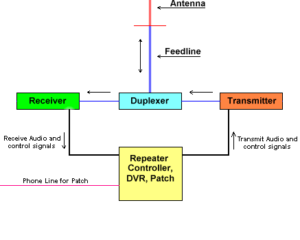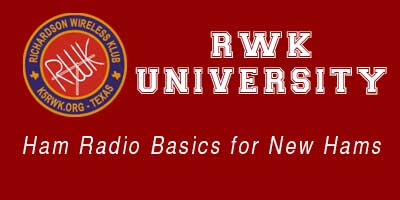There is more to VHF-FM voice than just traditional analog FM modulation. Over the past decade or so, Hams have taken advantage of the evolution of commercial technology used for public service and fleet radios. Basically a need to shrink the bandwidth of the signal so that more users can be packed into the same amount of channels has caused most commercial radios to evolve to digital FM modulation. Ham radio has made the same evolution.
Analog vs Digital Voice Modulation
Traditional analog modulation of a FM signal results in a classic “wideband” FM waveform that is 15 kHz wide. Although not that wide compared to other services (commercial FM broadcast radio is almost 200 kHz wide), a 15 kHz signal still consumes a significant amount of bandwidth for a single conversation. It’s a bit over 5 times as wide as a SSB signal on HF, which is around 2.7 kHz wide. The standards for UHF/VHF FM modulation are similar between amateur and commercial/public service/land mobile services, and there is a great deal of overlap between equipment makers between all the services. However, a couple of decades ago, there was significant demand for more licenses and the commercial services were running out of frequencies. This forced the FCC to require the commercial services to switch to narrowband deviation of half the wideband standard (6.25 kHz). This change, along with channel sharing with tone squelch (Motorola called theirs “Private Line” or PL, a name which still endures today) temporarily eased the congestion.
There was also an increasing demand for combined voice/data service, which required two separate analog channels. The equipment manufacturers developed several digital modulation standards that met that demand as well as allowed more channel sharing between users. DMR (Digital Mobile Radio) is probably the most popular among commercial and land mobile services. DMR uses TDMA (Time Division Multiple Access) modulation to split a single channel into two separate “timeslots”, each completely independent from the other. These timeslots can be shared by one user – voice on one and data on the other – or can be split between two completely independent users. Hams have adopted the same technology and it is being used in a similar way.
Since the amateur bands didn’t (yet) have the congestion demands and we are still using a good bit of “legacy” (old) equipment, there was no corresponding demand for everyone to switch to narrowband or to digital voice for ham radio. Today you will find a very interesting mix of wideband analog, narrowband analog, and digital voice repeaters in ham radio, increasing the challenge on just how to program your radio and what you will use when you do. Your best bet is to ask around your local group – they will be glad to help you.
Popular Digital Voice Modes
Within ham radio UHF/VHF systems, there are three different, competing, and non-interoperable digital voice modes:
DMR – This uses the technology as described above to split a channel into timeslots 1 & 2 (TS1 & TS2). A DMR repeater can carry two completely independent simultaneous conversations on the same channel. Usually these are assigned to different “talk groups” (see below for more on talkgroups). In addition to programming your radio for frequency and access encoding, you will also select whether to transmit on TS1 or TS2 and which talkgroup you are addressing. In addition to this, each DMR user is assigned a DMRID (tied to your callsign) that identifies you on every transmission (but that doesn’t remove the requirement that you identify by voice according to FCC regulations). This become a lot to set in the radio, so this information is usually programmed in advance into radio memory locations – a collection of memory location and radio configuration programming for a radio is sometimes referred to as a “code plug”.
Fusion – Fusion is a specific format that was created by Yaesu (sometimes called Yaesu System Fusion, or YSF). It is very similar to DMR in that it uses two timeslots on the same channel, but the primary Fusion mode uses one slot for voice and the other for data, shared by the same user. When you receive a fusion transmission, you will also see on the radio’s display the sender’s callsign and the repeater that you are connected to – this information is sent on the data timeslot while the audio is on the audio timeslot. As with DMR, you are required to program your callsign into the radio and your callsign is sent with every transmission. See below for more information about linking fusion repeaters together.
D-STAR – D-Star is a digital voice system created by Icom.
Repeater Inter-Networking

Consider the basic repeater block diagram that we saw in T100. Audio is decoded by the Receiver and is sent to the Repeater Controller and Audio to be transmitted is sent from the controller to the Transmitter. A very simple repeater controller just passes the received audio to the transmitter and periodically inserts a station ID. Simple controllers many years ago were hardware logic, but with micro-controllers we can do so much more!
Using intelligent repeater controllers, we can take the received audio from the repeater and send it miles or even thousands of miles away to other repeaters, and we can transmit audio that was received on another repeater thousands of miles away. This is known as repeater linking, and it has become a very popular function for lots of ham repeaters. Let’s look at the various ways that repeaters can be linked:
AllstarLink
AllstarLink (“Allstar”) is a popular and flexible way to interlink analog repeater systems over long distances using the internet. Allstar is basically an extended distributed phone switch, where each repeater is an phone extension and can dial and connect to another extension (repeater) or group of extensions. Just like a regular wire phone line, voice signals are bi-directional and simultaneous and very high quality. In addition to linking, an Allstar node (single repeater controller) can provide all the basic control functions that a repeater would need (such as IDs, messages, timers, etc.).
Wires-X / C-Bridge
The digital voice standards from the major radio vendors (Motorola for DMR and Yaesu for System Fusion) have their own proprietary inter-networking standards.
Motorola and derivative system repeaters use a linking system called C-Bridge (short for conference bridge). A C-bridge controller is hosted somewhere on the internet (or private network) and the various linked repeaters are connected to the C-bridge central controller via IP. The C-Bridge central controller hosts various “talkgroups” (think of them as individual meeting rooms), and depending on user input on a repeater (usually via a pre-programmed entry in the user’s radio), the repeater the user is communicating with is joined to a talkgroup (room). Other users on other repeaters that are also joined to that same talkgroup (room) will hear each other and can communicate. Each talkgroup is like a wide-area repeater system.
Users of Yaesu’s System Fusion can similarly link using the Wires-X linking on some fusion repeaters. Fusion users, like DMR, can join a variety of rooms that are networked across the country and even the world.
In Richardson, the RWK has both a DMR Repeater (joined to other DMR repeaters through a C-Bridge) and a System Fusion repeater (joined to other repeaters through Wires-X linking). As you would expect with proprietary vendor-based systems, our DMR repeater cannot talk to our System Fusion repeater! There are translators (sometimes called XLX – Cross-Link Translator – servers that can cross-translate the digital voice protocol between the two), but we don’t see a need for that.
Echolink
A final method of linking is called Echolink. Echolink has been around for many years and originated in the days of dial-up networking. It started as a method for individual hams to “dial into” remote repeaters using computers and modems – some people still use it this way – but Echolink has been expanded to serve as a inter-repeater linking method as well. Although improvements have been made to certain software versions recently, Echolink still suffers from very poor audio quality compared to the other methods of linking described above.

What Do I Use?
In most cases, you should probably use the mode(s) that are preferred by your local group or radio club. While some clubs or associations offer multiple systems with multiple modes (RWK has analog, Fusion, and DMR systems), most smaller groups will have collected around a simpler set of choices. For example, a local group may just have a single analog repeater or one that operates as both a fusion and analog repeater. Then your choice is easy – there’s no reason to get a radio that’s not going to be used, and currently there is no such thing as a single radio that does everything!
Digital Voice Radios
Yaesu offers several UHF/VHF mobile and home radios that contain their Fusion modulation in addition to analog voice.
DMR radios are available as repurposed commercial gear from Motorola and Kenwood, as well as popular suppliers such as Alinco, TYT, and Radioddity.
D-Star is mostly an Icom feature and is available in their HT, mobile and home radios.
Talkgroups
Popular talkgroups
Home Hot-Spots
If there is no local Digital Voice Repeater in your local area, you can still talk to other hams using DV modes using a small backyard repeater commonly referred to as a “hot spot”. Hot Spots consist of a small very low power radio, a specialty Digital Voice modem, and a small computer that connects to the internet. You can talk from your DV radio to the “hot spot”, where your signal is received, demodulated, and sent via the internet to a conference bridge, where you can communicate with other users using the same DV mode. The conference bridges are organized into “talk groups”, usually based on geography or topic (there are hundreds of talkgroups – one is for amateur satellites and another talkgroup about railroads). The range of a common hot spot is several hundred feet, allowing you to leave it (unattended) in a central location and roam around your house and yard while talking.
Next: T500 – VHF Data Modes – Packet/APRS
RWK University original content is Copyright 2022 by the Chip Coker KD4C and the Richardson Wireless Klub. Reproduction, extraction or use of this material by any other entity is with explicit permission only.
